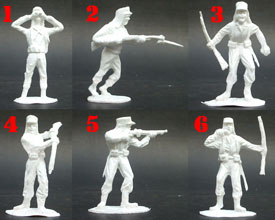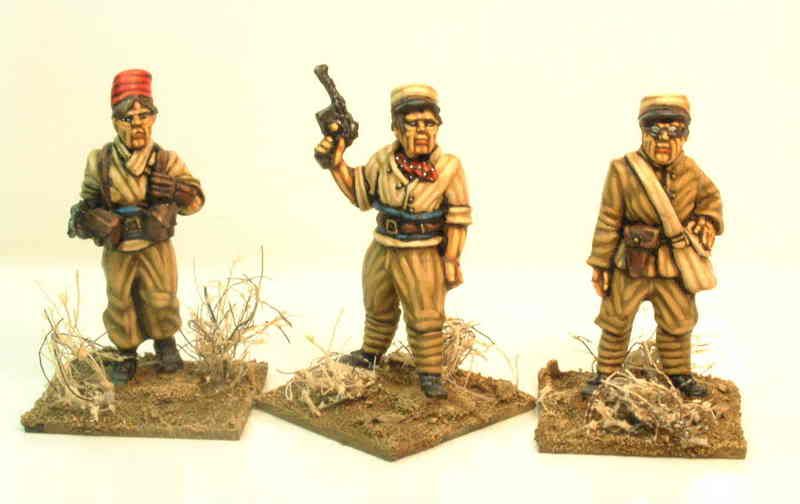Captain Gallant of the Foreign Legion was a half-hour black-and-white television series about the French Foreign Legion starring Buster Crabbe in the title role. Crabbe's real-life son Cullen Crabbe played the Legion mascot, with cowboy sidekick Fuzzy Knight playing himself as Legion comedy relief. The series premiered on NBC on 13 February 1955 and ended its first run with the 65th episode shown on 7 December 1957[. It was shown for many years in syndication on American television under the title Foreign Legionnaire.
The series premiered on NBC on 13 February 1955 and ended its first run with the 65th episode shown on 7 December 1957[. It was shown for many years in syndication on American television under the title Foreign Legionnaire. the stirring adventure stories written by British author P.C. Wren in the 1930's, the Beau
the stirring adventure stories written by British author P.C. Wren in the 1930's, the Beau  Geste tales, in which a wrongly accused English gentleman does the decent thing, and takes the guilt for a crime he did not commit, so as to save a lady's honour.
Geste tales, in which a wrongly accused English gentleman does the decent thing, and takes the guilt for a crime he did not commit, so as to save a lady's honour.
Not being a complete mug, he then evades the long arm of British justice, skips to France, and signs up in the feared and brutal Légion Étrangère. Passing through the callous brutality of basic training, he is posted to Morocco to fight in the Rif wars against the Arabs.
He ends up in the dreaded outpost of Fort Zinderneuf, run by brutal officers and sergeants, where discipline is basic and straight to the point. A deserter is recaptured by local Arabs - who receive a cash bounty for bringing such men back alive - and punished by being buried in the sand up to his neck, and left in the blazing desert sun for three days. (Geste is beaten by the sergeant for sneaking him some water). When the hostile Tuareg Arabs (D'regs) attack the fort in force and nearly overwhelm it, Beau Geste has the idea of propping dead men up on the walls with their rifles, to make the fort look more strongly defended than it really is. (Compare this to "Beau Nidle" taking the idea a step further) The idea that "men join the Legion to forget" was coined for these books...the legionaaires above could easily be converted to 30's ones by making the kepi less pronounced and paint job.
When the hostile Tuareg Arabs (D'regs) attack the fort in force and nearly overwhelm it, Beau Geste has the idea of propping dead men up on the walls with their rifles, to make the fort look more strongly defended than it really is. (Compare this to "Beau Nidle" taking the idea a step further) The idea that "men join the Legion to forget" was coined for these books...the legionaaires above could easily be converted to 30's ones by making the kepi less pronounced and paint job..jpg)
 the stirring adventure stories written by British author P.C. Wren in the 1930's, the Beau
the stirring adventure stories written by British author P.C. Wren in the 1930's, the Beau  Geste tales, in which a wrongly accused English gentleman does the decent thing, and takes the guilt for a crime he did not commit, so as to save a lady's honour.
Geste tales, in which a wrongly accused English gentleman does the decent thing, and takes the guilt for a crime he did not commit, so as to save a lady's honour.
Not being a complete mug, he then evades the long arm of British justice, skips to France, and signs up in the feared and brutal Légion Étrangère. Passing through the callous brutality of basic training, he is posted to Morocco to fight in the Rif wars against the Arabs.
He ends up in the dreaded outpost of Fort Zinderneuf, run by brutal officers and sergeants, where discipline is basic and straight to the point. A deserter is recaptured by local Arabs - who receive a cash bounty for bringing such men back alive - and punished by being buried in the sand up to his neck, and left in the blazing desert sun for three days. (Geste is beaten by the sergeant for sneaking him some water).
 When the hostile Tuareg Arabs (D'regs) attack the fort in force and nearly overwhelm it, Beau Geste has the idea of propping dead men up on the walls with their rifles, to make the fort look more strongly defended than it really is. (Compare this to "Beau Nidle" taking the idea a step further) The idea that "men join the Legion to forget" was coined for these books...the legionaaires above could easily be converted to 30's ones by making the kepi less pronounced and paint job.
When the hostile Tuareg Arabs (D'regs) attack the fort in force and nearly overwhelm it, Beau Geste has the idea of propping dead men up on the walls with their rifles, to make the fort look more strongly defended than it really is. (Compare this to "Beau Nidle" taking the idea a step further) The idea that "men join the Legion to forget" was coined for these books...the legionaaires above could easily be converted to 30's ones by making the kepi less pronounced and paint job..jpg)
Most of the stories recounted in the books have some basis in fact; France (and neighbour Spain) co-operated in wars in their North African colonies (Algeria, Tunisia and the Moroccos) against Tuareg Arabs fighting an Islamic Jihad to throw out the infidels.below BMC conversions Both countries had Foreign Legions composed of the lost and unlucky which were used for preference in these colonial actions. While the French had some success in supressing Arab insurrection in Algeria, the Spanish were at first humiliatingly defeated with the loss of up to 30,000 troops. A chain of forts, along the Fort Zinderneuf model, were key to frontier security:
Both countries had Foreign Legions composed of the lost and unlucky which were used for preference in these colonial actions. While the French had some success in supressing Arab insurrection in Algeria, the Spanish were at first humiliatingly defeated with the loss of up to 30,000 troops. A chain of forts, along the Fort Zinderneuf model, were key to frontier security: while the French held theirs against often savage assaults, the Spanish forts fell like dominos to the Moroccan insurrectionists. (Interestingly, the Spanish general who finally held the line in what they could hold of Morocco was one Francisco Franco, a man whose rage and humiliation at colonial defeat led him to start a Civil War...)
while the French held theirs against often savage assaults, the Spanish forts fell like dominos to the Moroccan insurrectionists. (Interestingly, the Spanish general who finally held the line in what they could hold of Morocco was one Francisco Franco, a man whose rage and humiliation at colonial defeat led him to start a Civil War...)
 Both countries had Foreign Legions composed of the lost and unlucky which were used for preference in these colonial actions. While the French had some success in supressing Arab insurrection in Algeria, the Spanish were at first humiliatingly defeated with the loss of up to 30,000 troops. A chain of forts, along the Fort Zinderneuf model, were key to frontier security:
Both countries had Foreign Legions composed of the lost and unlucky which were used for preference in these colonial actions. While the French had some success in supressing Arab insurrection in Algeria, the Spanish were at first humiliatingly defeated with the loss of up to 30,000 troops. A chain of forts, along the Fort Zinderneuf model, were key to frontier security: while the French held theirs against often savage assaults, the Spanish forts fell like dominos to the Moroccan insurrectionists. (Interestingly, the Spanish general who finally held the line in what they could hold of Morocco was one Francisco Franco, a man whose rage and humiliation at colonial defeat led him to start a Civil War...)
while the French held theirs against often savage assaults, the Spanish forts fell like dominos to the Moroccan insurrectionists. (Interestingly, the Spanish general who finally held the line in what they could hold of Morocco was one Francisco Franco, a man whose rage and humiliation at colonial defeat led him to start a Civil War...)
What the Legion called le cafard was an occupational hazard in North Africa: a catatonic, listless, fugue mental state brought on by the sheer monotony of existence in a barren hostile desert. One of its symptoms was loss of memory and amnesia - so perhaps the Klatchian Foreign Legion is not so far off the truth after all...

A final level of association: author George McDonald Fraser was in command of such a fort, in the immediate aftermath of WW2, when North Africa was being administered by the British. His adventures at Fort Zarhuna, the only ex-Foreign Legion fort to be garrisoned by Scottish Highlanders, and which was indeed "attacked" by raiding Arabs, are recounted in McAuslan in the Rough. (A book known to have been read by Terry Pratchett, and part of the background inspiration for the Nac Mac Feegle).


No comments:
Post a Comment